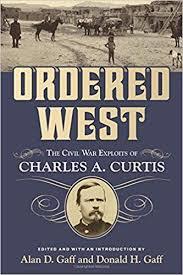Ordered West: One Soldier's Account of Life in the Territory
 I love writing historical fiction.
I love writing historical fiction. And I really love doing the research. I read over 20 books as I researched Glorieta, the second in my trilogy about the Civil War in New Mexico.
One of the books that I really enjoyed was Ordered West: The Civil War Exploits of Charles A. Curtis.I couldn't use much of what I read in Glorieta; by the time Curtis came to New Mexico in 1862, the Confederates had already lost and were heading back south to Fort Bliss, on their way home to San Antonio. Some of What I read might end up in Peralta, the third and final book in my series.
Charles Curtis came to New Mexico with the 5th United States Infantry. He stayed here on garrison duty until 1865. Years after his service, Curtis wrote a memoir of his time in New Mexico and Arizona while he was president of Norwich University. His memoir was serialized and published in a New England newspaper. Alan and Donald Gaff compiled those stories into a book that is heavily and informatively footnoted so that the reader knows who Curtis is referring to. There are also lots of pictures and maps to help orient the reader.
But what I really found interesting were Curtis' descriptions of places in New Mexico that I could identify. One place he talks about is the aguas termales in the Jemez mountains, hot springs so hot that he claims to have frequently boiled eggs in them.Curtis says that in the river opposite the spring was an island about a hundred feet long and encrusted with sulfur so pure that it would burn when lighted with a match. Anyone who's ever been to the Soda Dam knows exactly what he is talking about. Another interesting episode is the building of winter quarters near Peralta, New Mexico. Curtis describes how the whole command goes into a low area near the river and cuts terrunos (turfs) using axes and spades. The thick, clayey turf is scored with long parallel lines, cut across every nine inches. Each terron was about six inches tall. These were stacked six feet tall, using local mud as mortar to make huts that were the same size as the tents the men used in summer. Stout spars were lashed together and set over the hut and a wall tent was pitched over the top of the spars to make a roof. No windows were necessary since light came through the canvas. Each hut had a wide, open fireplace in the back wall and a wooded door hung on hinges at its front. Curtis says that the alkali soil from which the huts were made dried white and crusty, making the huts look like they were covered with frost. After the hut was made, water was poured on the floors and more dirt added until the floor was a foot higher than the outside. When dry, Curtis said the floor was hard and solid. I have seen lots of pictures of Fort Craig and Fort Union, but this description of how quarters were built really brought the process to life for me.
 Jennifer Bohnhoff is an author and educator who lives in the mountains east of Albuquerque. You can read more about her books here.
Jennifer Bohnhoff is an author and educator who lives in the mountains east of Albuquerque. You can read more about her books here. Ordered West is available from the Albuquerque Public Library, on Amazon, and through independent bookstores.
Published on March 02, 2020 00:00
No comments have been added yet.



